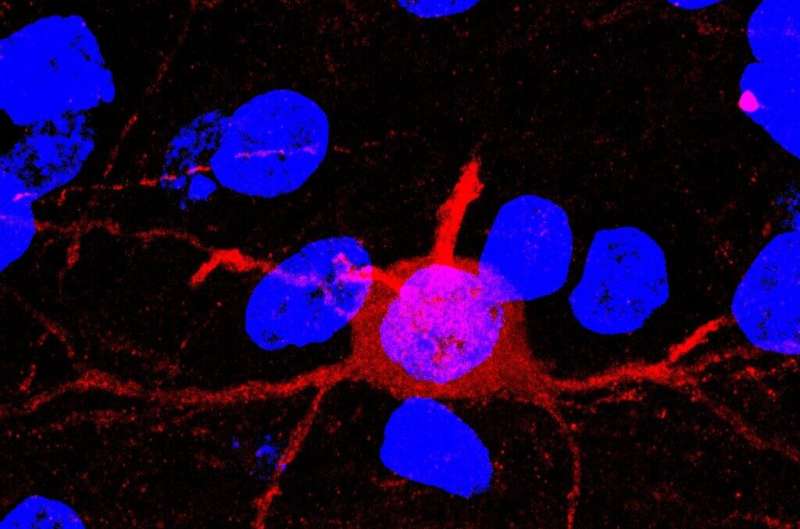This article has been reviewed according to Science X's editorial process and policies. Editors have highlighted the following attributes while ensuring the content's credibility:
fact-checked
peer-reviewed publication
trusted source
proofread
A new epigenetic brain defense against recurrence of opioid use

Substance use disorder (SUD) is an extremely difficult disorder to overcome, and many individuals with SUD return to regular use after repeated attempts to quit.
A return to regular drug use can be caused by the body's physical dependence on the drug as well as experiences associated with prior drug use. Exactly how these drug associations are formed in the brain and how they trigger a return to drug use remain unclear.
"Individuals make long-lasting associations between the euphoric experience of the drug and the people, places and things associated with drug use," said Christopher Cowan, Ph.D. professor in the Department of Neuroscience at the Medical University of South Carolina (MUSC) and member of the Brain and Behavior Research Foundation Scientific Council.
Cowan and his team report in the Proceedings of the National Academy of Sciences that an enzyme known as histone deacetylase 5, or HDAC5, plays a significant role in limiting heroin-associated memories and drug-seeking behavior following a period of abstinence in rats.
The study reveals HDAC5 as a target of interest in treating vulnerability to return to drug use in opioid use disorder.
HDAC5 is an "epigenetic" enzyme, meaning it can influence the expression of many different genes. HDAC5 is active in the brain and has been associated previously with resumed cocaine use after a period of abstinence.
"In a prior study, we showed that HDAC5 is regulated by cocaine, and it reduces the impact of substance use triggers following cocaine use," said Cowan. "In the new study, we wanted to learn why HDAC5 had these effects and if they were specific to cocaine or perhaps generalizable to other classes of addictive drugs, like opioids."
Cowan examined drug-seeking behaviors by modelling a return to opioid use in rats after a period of abstinence from self-administration of heroin, a commonly used opioid drug.
First, rats were given the opportunity to self-administer heroin by pressing a lever. At the same time, they were presented with visual and audio cues that they associated with their heroin use.
Then, after 2-3 weeks of daily heroin use, the rats went through a week of abstinence before being placed back in the environment where they formerly used heroin. This drug-associated "place" triggered the pressing of the lever, or heroin seeking, but in this case no heroin was delivered.
Later, drug-seeking behavior was stimulated in the rats by exposing them to the visual and audio cues formerly linked to their heroin use.
Finally, the rats were given a small dose of heroin to remind them of the feeling of the drug, and again, this stimulated vigorous heroin seeking.
"By seeing how many times the rats press the lever while not getting the drug, we can measure the strength of the drug-use context, the drug-associated memory cues or the re-exposure to physiological drug effects to promote return to heroin use," explained Cowan.
To see how HDAC5 controlled drug-seeking behavior after a period of abstinence, Cowan's lab used a molecular trick to either increase or decrease the levels of HDAC5 in the nucleus, or DNA-containing site, of their targeted brain cells.
Rats with lower HDAC5 showed enhanced heroin seeking when exposed to triggers, while rats with higher HDAC5 showed reduced heroin-seeking behavior. This finding showed that the epigenetic enzyme HDAC5 plays a critical role in modulating the power of drug-associated memories and preventing a return to drug use.
"We found that HDAC5 limits heroin-associated cues and opposes the powerful nature of these drug cues to trigger drug-seeking behavior," said Cowan. "This suggests that, in the brain, HDAC5 functions to influence the formation and strength of these drug memories that can promote a return to drug use."
To ensure that their findings were specific to drug-seeking behavior and not just general reward seeking, Cowan's lab repeated the same experiment but used sucrose instead of heroin. Sucrose is a simple sugar that rats enjoy consuming and serves as a natural reward.
"There was absolutely no effect of HDAC5 on sucrose-seeking behavior," said Cowan. "So, it seems that addictive drugs, like cocaine and heroin, are engaging HDAC5 in a way that is separate from our natural reward learning and memory process."
After observing the effects of HDAC5 on drug-seeking behavior, Cowan's lab investigated what genes HDAC5 was actually controlling.
"We found hundreds of genes affected by HDAC5," said Cowan. "But a large number of the genes are linked to ion channels that influence the excitability of neuronal cells in the brain."
Rats with higher levels of HDAC5 had much less excitable neurons than those with low HDAC5, showing that the enzyme has a suppressive effect.
"The firing suppression from HDAC5 is likely a key underlying mechanism controlling the formation and strength of drug-associated memories," said Cowan.
With a better understanding at a molecular level of drug addiction and return to drug use, scientists and physicians can develop targeted therapies to treat SUD. Future studies in Cowan's lab aim to leverage HDAC5 to make the road to recovery less challenging.
"We have uncovered a mechanism in the brain that is controlling the formation and maintenance of really powerful and enduring drug-cue associations," said Cowan. "We want to translate these findings to the clinic and help individuals with substance use disorder by reducing vulnerability to return to regular drug use."
More information: Ethan M. Anderson et al, Epigenetic function during heroin self-administration controls future relapse-associated behavior in a cell type-specific manner, Proceedings of the National Academy of Sciences (2023). DOI: 10.1073/pnas.2210953120

















